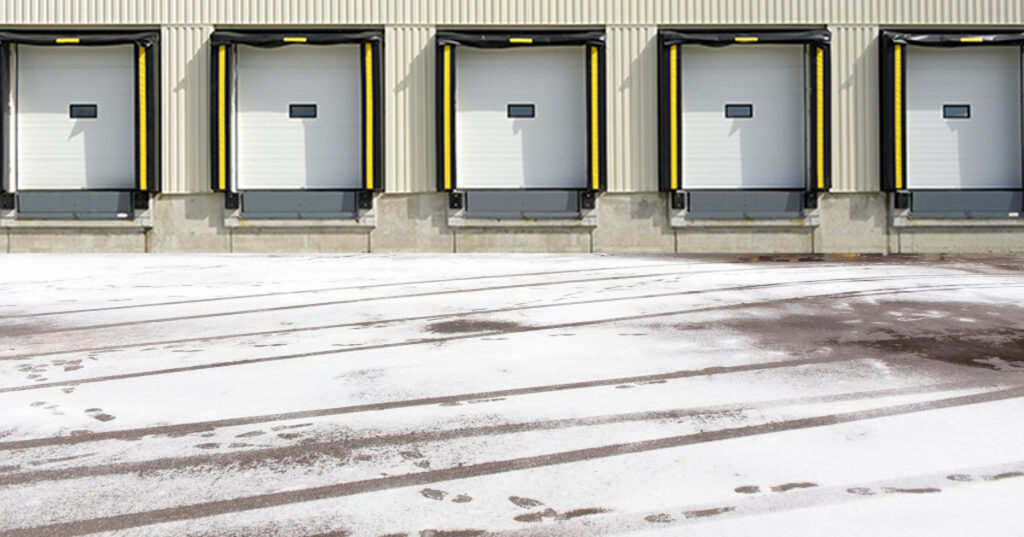As winter blankets your location in a serene layer of snow, this beauty can create a unique set of challenges for your business, particularly if it’s dependent on material handling solutions for seamless operations. The arrival of frosty weather introduces the need for heightened caution and strategic planning when it comes to utilizing essential equipment like your portable loading dock ramp.
In this blog, we’ll delve into winter-specific tips for using portable loading docks, also known as yard ramps, to help your business navigate the winter season without compromising on productivity or safety. Winter may present its challenges, but armed with the right knowledge and precautions, you can transform the coldest season into a period of smooth and secure operations.
Properly Storing Your Yard Ramp in the Winter
Tip #1: Store your Yard Ramp Under a Tarp
Before we get into the usage, it’s important to address the storage of your portable loading dock in the winter. Ideally, you’d want to store your yard ramp indoors somewhere inside your warehouse. However, this isn’t realistic for most locations because there’s rarely any space in a warehouse that isn’t already being used.
If storing your ramp outside, it is best to invest in a large, heavy-duty tarp to cover the entirety of the ramp. This will prevent any snow, ice, and debris from settling on the ramp and will also save you time by not having to clear the ramp before use.
Tip #2: Store your Yard Ramp According to How You Use It
The storage placement of your yard ramp in your shipping and receiving yard will depend on how much free space you have available as well as the consistency of your loading operations. If business slows down a bit in the winter and you won’t be using the portable loading dock as often, you’ll want to store it as far away from your dock doors as possible. This ensures that the ramp is completely out of the way and won’t be damaged by forklifts or other vehicles working in the area.
If business is just as busy in the winter as it is in the warmer months, it’s a good idea to store your yard ramp closer to your dock doors so you don’t have to move it too far, especially if the weather is hitting your work area with a slurry of snow and ice.
Additionally, properly storing your yard ramp will help prevent damage and increase its lifespan regardless of the weather or season.
Important Work Area Preparation in the Winter
Tip #3: Make Sure the Work Area is Clear of Other Equipment
As with any job, safety is paramount when working with a portable loading dock. Cluttered work areas increase the risk of accidents and injuries. When things like pallets, vehicles, or other equipment are left in the path of a yard ramp, it poses a hazard during loading and unloading operations. Coupled with the slippery weather winter can bring, it’s crucial to give the work area a once over and move anything that might get in the way.

Tip #4: Employ Consistent Snow & Ice Removal
Specific to winter weather, it’s also important that the work area be cleared of any snow and ice. While many forklifts have the ability to drive through snow and slippery conditions, it doesn’t mean that it doesn’t also come with risks. Employing consistent snow removal and preventing ice formation with salt will help keep both your payloads and employees safe.
Tip #5: Keep the Area Well-lit
Besides the snow, sleet, and ice, the winter season also brings less daylight. In some months, it can be dark outside before 4 PM. Inadequate lighting in work areas during these conditions can lead to reduced visibility, increasing the risk of accidents, collisions, and slips. Well-lit spaces enhance visibility, allowing your team members to navigate the area safely and identify potential hazards during the loading and unloading process. If your location doesn’t already have lighting permanently installed throughout your shipping and receiving yard, it is crucial to place portable work lights throughout the work area to keep it well-lit on those short winter days.
Winter Yard Ramp Safety
Tip #6: Keep a Consistent Maintenance Schedule
While consistent maintenance is a year-round task, it is especially important during wintertime. Regular maintenance, including inspections, lubrication of moving parts, and addressing any signs of wear or corrosion, helps identify and rectify issues before they escalate. This proactive approach not only prevents costly repairs and unplanned downtime but also safeguards against potential safety hazards, ensuring that the yard ramp operates seamlessly during critical operations in less-than-satisfactory winter weather.
Tip #7: Clearing Your Yard Ramp of Snow and Ice
Because Industrial Toolz yard ramps have a serrated steel surface, they can be used in slippery winter conditions. The serrated surface prevents snow and ice from forming on top of the ramp and creates traction for the forklifts and other vehicles that will be using the ramp. However, if your ramp is stored without a tarp, heavy snowfall, and freezing temperatures can cause snow and ice to form on top of the ramp. In these situations, the snow and ice should be shoveled off to ensure unobstructed and smooth movement of the forklift or other vehicles on the ramp.
Your Year Round Yard Ramp Experts
Winter doesn’t have to be a roadblock for businesses relying on yard ramps to keep their material handling operations going. By implementing certain safety measures and maintaining your ramp properly, your portable loading dock will continue to contribute to safe and efficient loading operations in even the chilliest of winter weather. Especially with Industrial Toolz’ expertise on your side, you can be sure that your yard ramp will serve your business for seasons and years to come.
Whether you’re interested in renting, buying new, buying a used yard ramp, or just have a question, our team of ramp experts is at your service! Just give us a call at 262-671-5000 or inquire here.
